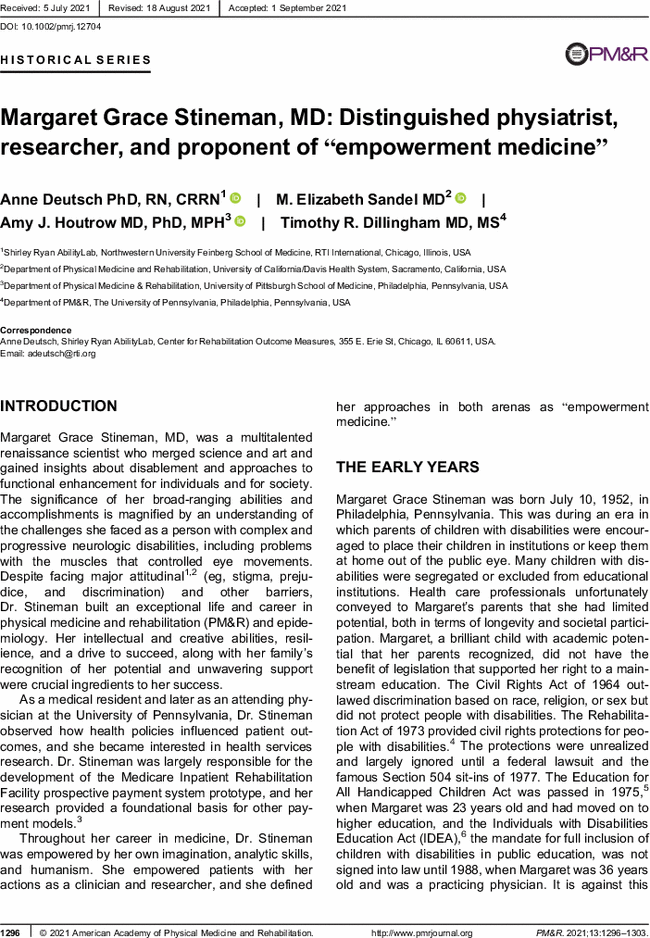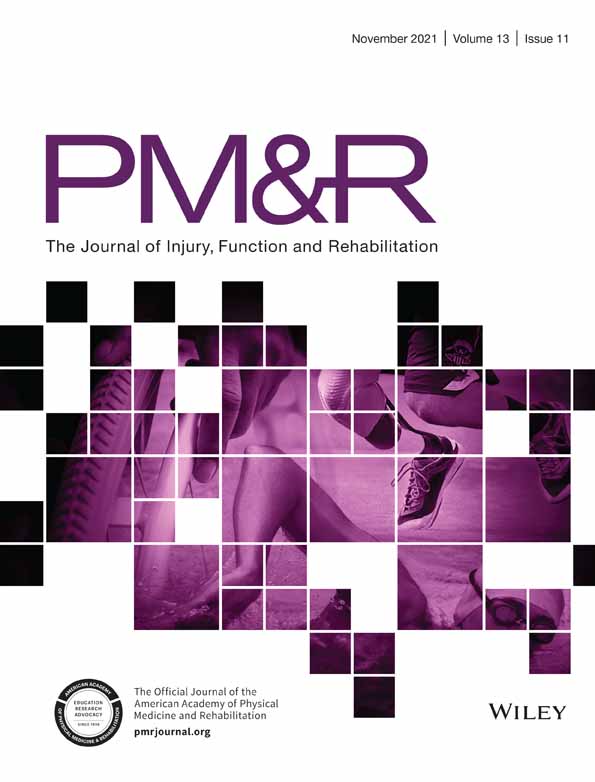Margaret Grace Stineman, MD: Distinguished physiatrist, researcher, and proponent of “empowerment medicine”
Corresponding Author
Anne Deutsch PhD, RN, CRRN
Shirley Ryan AbilityLab, Northwestern University Feinberg School of Medicine, RTI International, Chicago, Illinois, USA
Correspondence
Anne Deutsch, Shirley Ryan AbilityLab, Center for Rehabilitation Outcome Measures, 355 E. Erie St, Chicago, IL 60611, USA.
Email: [email protected]
Search for more papers by this authorM. Elizabeth Sandel MD
Department of Physical Medicine and Rehabilitation, University of California/Davis Health System, Sacramento, California, USA
Search for more papers by this authorAmy J. Houtrow MD, PhD, MPH
Department of Physical Medicine & Rehabilitation, University of Pittsburgh School of Medicine, Philadelphia, Pennsylvania, USA
Search for more papers by this authorTimothy R. Dillingham MD, MS
Department of PM&R, The University of Pennsylvania, Philadelphia, Pennsylvania, USA
Search for more papers by this authorCorresponding Author
Anne Deutsch PhD, RN, CRRN
Shirley Ryan AbilityLab, Northwestern University Feinberg School of Medicine, RTI International, Chicago, Illinois, USA
Correspondence
Anne Deutsch, Shirley Ryan AbilityLab, Center for Rehabilitation Outcome Measures, 355 E. Erie St, Chicago, IL 60611, USA.
Email: [email protected]
Search for more papers by this authorM. Elizabeth Sandel MD
Department of Physical Medicine and Rehabilitation, University of California/Davis Health System, Sacramento, California, USA
Search for more papers by this authorAmy J. Houtrow MD, PhD, MPH
Department of Physical Medicine & Rehabilitation, University of Pittsburgh School of Medicine, Philadelphia, Pennsylvania, USA
Search for more papers by this authorTimothy R. Dillingham MD, MS
Department of PM&R, The University of Pennsylvania, Philadelphia, Pennsylvania, USA
Search for more papers by this author
Supporting Information
| Filename | Description |
|---|---|
| pmrj12704-sup-0001-Supinfo.docxWord 2007 document , 100.8 KB | Appendix S1. Supporting Information |
Please note: The publisher is not responsible for the content or functionality of any supporting information supplied by the authors. Any queries (other than missing content) should be directed to the corresponding author for the article.
REFERENCES
- 1Freer JR. The tripartite intervention: breaking down attitudinal barriers in education. J Disabil Stud Educ. 2021; 1(aop: 1-27.
10.1163/25888803-bja10006 Google Scholar
- 2Whiteneck GG, Harrison-Felix CL, Mellick DC, Brooks C, Charlifue SB, Gerhart KA. Quantifying environmental factors: a measure of physical, attitudinal, service, productivity, and policy barriers. Arch Phys Med Rehabil. 2004; 85(8): 1324-1335.
- 3 Department of Health and Human Services. Medicare program; prospective payment system for inpatient rehabilitation facilities; proposed rule. Fed Regist. 2000; 65(214): 66304-66442.
- 4Wegner JW. The antidiscrimination model reconsidered: ensuring equal opportunity without respect to handicap under Section 504 of the Rehabilitation Act of 1973. Cornell Law Rev. 1984; 69(3): 401-516.
- 5 Education for All Handicapped Children Act PL 94-142 (1975). https://www.govtrack.us/congress/bills/94/s6
- 6Lipkin PH, Okamoto J, Council on Children With D, Council on School H. The Individuals with Disabilities Education Act (IDEA) for children with special educational needs. Pediatrics. 2015; 136(6): e1650-e1662.
- 7Burling S. Penn doctor's disabilities a springboard to helping others. Philadelphia Inquirer. July 6, 2011.
- 8 Oral History Interview with Margaret Stineman, MD - Elizabeth Sandel MD Interviewer Rosemont, IL: American Academy of Physical Medicine and Rehabilitation Archives (videotape transcript); July 31, 2010
- 9Stineman MG, Escarce JJ, Goin JE, Hamilton BB, Granger CV, Williams SV. A case-mix classification system for medical rehabilitation. Med Care. 1994; 32(4): 366-379.
- 10Hamilton BB, Laughlin JA, Fiedler RC, Granger CV. Interrater reliability of the 7-level functional independence measure (FIM). Scand J Rehabil Med. 1994; 26(3): 115-119.
- 11Stineman MG, Fiedler RC, Granger CV, Maislin G. Functional task benchmarks for stroke rehabilitation. Arch Phys Med Rehabil. 1998; 79(5): 497-504.
- 12Stineman MG, Ross RN, Williams SV, Goin JE, Granger CV. A functional diagnostic complexity index for rehabilitation medicine: measuring the influence of many diagnoses on functional independence and resource use. Arch Phys Med Rehabil. 2000; 81(5): 549-557.
- 13Carter GM, Relles DA, Buchanan JL, et al. A Classification System for Inpatient Rehabilitation Patients: a Review and Proposed Revisions to the Functional Independence Measure-Function Related Groups. Washington, DC: US Department of Commerce, National Technical Information Services; 1997.
- 14Stineman MG. The story of function-related groups—please, first do no harm. Arch Phys Med Rehabil. 2001; 82(4): 553-557.
- 15Stineman MG. Prospective payment, prospective challenge. Arch Phys Med Rehabil. 2002; 83(12): 1802-1805.
- 16Gage B, Ingber M, Smith L, et al. Post-Acute Care Payment Reform Demonstration: Final Report Volume 4 of 4. RTI International; 2012.
- 17 World Health Organization. International Classification of Functioning, Disability and Health. Geneva: World Health Organization; 2001.
- 18Stineman MG, Streim JE. The biopsycho-ecological paradigm: a foundational theory for medicine. PM R. 2010; 2(11): 1035-1045.
- 19Stineman MG, Ross RN, Maislin G, Gray D. Population-based study of home accessibility features and the activities of daily living: clinical and policy implications. Disabil Rehabil. 2007; 29(15): 1165-1175.
- 20Stineman MG. A model of health environmental integration. Top Stroke Rehabil. 2001; 8(2): 34-45.
- 21Hennessy S, Kurichi JE, Pan Q, et al. Disability stage is an independent risk factor for mortality in Medicare beneficiaries aged 65 years and older. PM R. 2015; 7(12): 1215-1225.
- 22Stineman MG, Ross RN, Fiedler R, Granger CV, Maislin G. Functional independence staging: conceptual foundation, face validity, and empirical derivation. Arch Phys Med Rehabil. 2003; 84(1): 29-37.
- 23Stineman MG, Ross RN, Fiedler R, Granger CV, Maislin G. Staging functional independence validity and applications. Arch Phys Med Rehabil. 2003; 84(1): 38-45.
- 24Stineman MG, Xie D, Pan Q, Kurichi JE, Saliba D, Streim J. Activity of daily living staging, chronic health conditions, and perceived lack of home accessibility features for elderly people living in the community. J Am Geriatr Soc. 2011; 59(3): 454-462.
- 25Kurz AE, Saint-Louis N, Burke JP, Stineman MG. Exploring the personal reality of disability and recovery: a tool for empowering the rehabilitation process. Qual Health Res. 2008; 18(1): 90-105.
- 26Stineman MG, Kurz AE, Kelleher D, Kennedy BL. The patient's view of recovery: an emerging tool for empowerment through self-knowledge. Disabil Rehabil. 2008; 30(9): 679-688.
- 27Stineman MG, Rist PM, Kurichi JE, Maislin G. Disability meanings according to patients and clinicians: imagined recovery choice pathways. Qual Life Res. 2009; 18(3): 389.
- 28Houtrow A. A tribute to Margaret Grace Stineman, MD. Arch Phys Med Rehabil. 2020; 101(12): 2250-2252.
- 29Margaret Grace Stineman, MD: 1952–2020; Obituary. The Philadelpia Inquirer, July 19. 2020. https://www.legacy.com/us/obituaries/inquirer/name/margaret-stineman-obituary?pid=196515807




